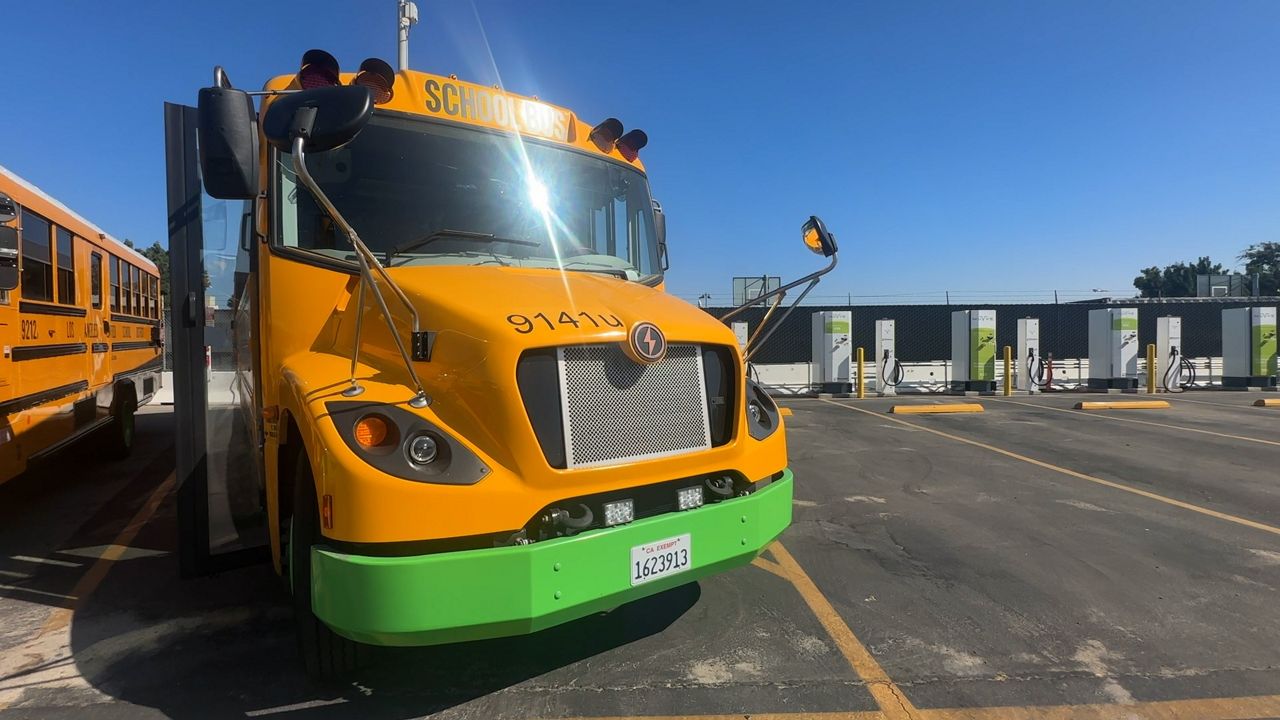LOS ANGELES — “This is the right investment at the right time for absolutely the right reason.” — That’s how LAUSD Superintendent Alberto M. Carvalho describes the district’s commitment to replacing its fleet of 1,300 school buses with zero-emission vehicles.
Among the first steps is transforming the bus yard in Sun Valley to an all-electric facility by 2026.
Daniel Kang, LAUSD’s Director of Transportation, says the hub used to be engulfed in a cloud of exhaust before the district began switching from diesel to alternative fuels like propane and CNG.
“It is a much cleaner environment, but we still have a lot of forward movement to go,” he explained. “We want to not have minimal exhaust fumes. We want to have zero.”
What You Need To Know
- The Zero-Emissions School Bus and Infrastructure (ZESBI) program dedicates $500 million to the purchase of electric school buses and infrastructure improvements to charge them
- California has set a target of having all zero emission school bus fleets by 2035
- This year, LAUSD put in a purchase order for 180 zero emission buses, which Superintendent Carvalho says will mean a reduction of 780,000 tons of carbon dioxide a year compared to diesel buses
- The Zero-Emissions School Bus and Infrastructure (ZESBI) program hopes to fund the purchase of 1000 electric school buses statewide
The state wants that, too.
California has set a target of having all zero-emission school bus fleets by 2035, and now it has launched a program to distribute $500 million to help schools achieve this goal.
Districts can apply for funding to purchase new electric buses and build the infrastructure needed to run them, like the high-speed bidirectional chargers at Sun Valley, which will allow the district to sell any power left in the bus at the end of the school day back to LADWP.
“During peak demand times, which is the late afternoon, when families are home, turning on all their appliances or getting ready for dinner,” Kang said, pointing out that by then, most of the buses are off the roads. “The battery goes back to the grid to support our local communities. It’s also a revenue source for the school district.”
This yard was chosen for several reasons, but the main one concerns their neighbor, Sun Valley Magnet.
“This is the only bus yard next to a school,” Kang said.

School board member Kelly Gonez is well aware of this, and she expects the electrification of this fleet to have an immediate impact on students.
“Students for years have complained of the smell of fuel while they’re trying to play outside,” she explained. “They will see cleaner air in their communities.”
A valley native, she points out that Sun Valley faces an array of pollution sources, is sandwiched between multiple freeways, and is located directly on the heels of Hollywood Burbank Airport.
This year, LAUSD placed a purchase order for 180 zero-emission buses. Superintendent Carvalho says that, compared to diesel buses, those buses alone will reduce 780,000 tons of carbon dioxide a year.
And cleaner air means healthier air.
Yana Garcia is the Secretary for Environmental Protection at Cal EPA and says children’s lungs are the most susceptible to air pollution.
“They’re still developing,” she explained. “When particulates get lodged, they have a bigger impact in smaller people, smaller lungs.”
Research shows that it can lead to a greater risk of heart disease, cancer, and asthma. According to the Los Angeles County Department of Public Health, one in 11 children in LA County has asthma.
The EPA has also found that schools can be a “hot spot” for air pollution, with buses and cars idling at pick-up. Children are affected even while riding the bus.
“While kids may spend less than 10% of their day on a bus,” Garcia said, “the air pollution exposure that they have during that 10% of their day can actually amount to a third of the air pollution exposure for the entire day.”
Kang, who has a daughter with asthma, points out that healthy kids mean better attendance.
“If you’re healthy, you’re in school, in class,” he said. “That means you’re able to learn and you’re ready.”
And since electric buses are exponentially quieter, he says drivers report the kids are calmer and quieter, too.
“That’s because they’re not speaking, they’re not in competition with the engine,” Kang explained. “They’re not trying to speak above the noise levels.”
Zero-emission buses do cost more than standard school buses—up to $450,000 each. The Zero-Emissions School Bus and Infrastructure (ZESBI) program hopes to fund the purchase of 1,000 electric school buses statewide.



